Forgive the pun, but I feel like there’s a very large eye on me, watching intently as I publish this review. The One Ring is the newest edition of the much beloved roleplaying game set in the lands of Middle Earth. A much beloved setting, in fact, with a great many fans. Whether you’re a player of this system from its first edition or you’re a Lord of the Rings buff, newly discovering the tabletop RPG, I think there’s a lot to like in this beautiful hardcover book. Or maybe you’re just looking to branch out your fantasy games from the typical D&D setting. That’s ok too!
It's something of a daunting task, though, reviewing a game linked with one of the most adored settings in all of fantasy. There’s a lot going on in this book, much of it emulating the various things we see in the novels and movies. There are long, sweeping journeys across the countryside. There are ruins of ages long past, and there are dangers lurking in the shadows. How does it all come together? And does this system offer players anything besides a chance to smack around some baddies in a Middle Earth sandbox? We’ve got some things to discuss.
 The One Ring
The One Ring
Author: Francesco Nepitello, James Michael Spahn, Jason Durall
Designer: Francesco Nepitello, Marco Maggi
Publisher: Free League
Format: Tabletop RPG
Price: 478 kr (about $45 USD)
Copy provided by publisher
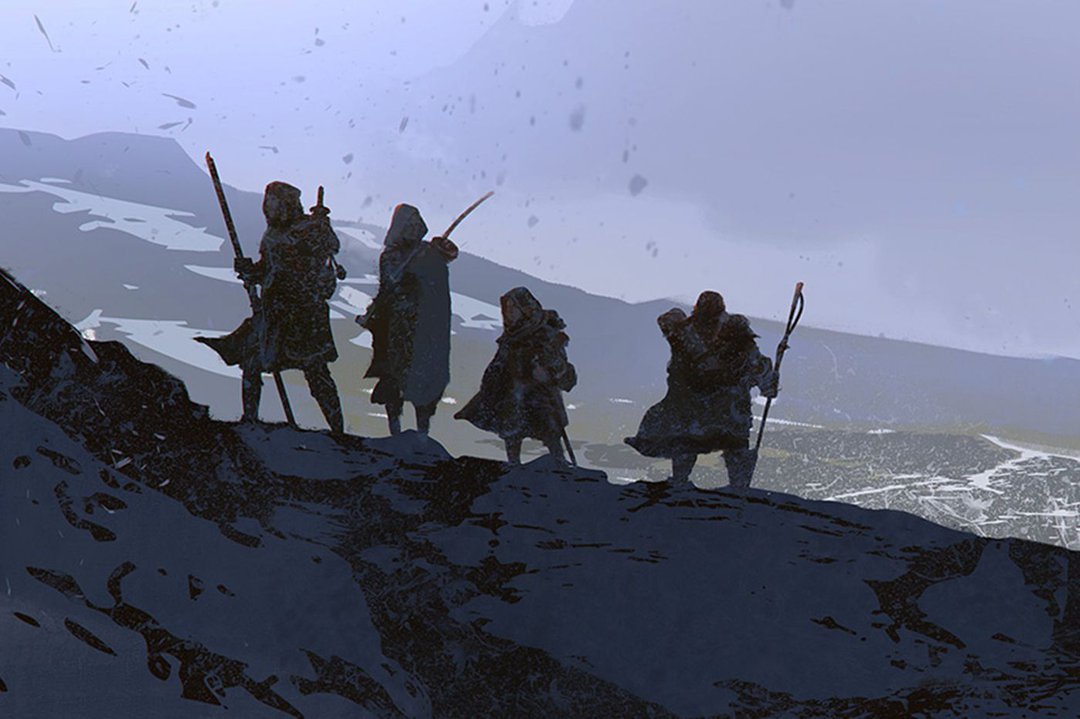
Are you ready to form a fellowship and begin an epic journey?
The Story As You Know It
The second edition of The One Ring takes place in the time directly following the retaking of Erebor, the Lonely Mountain, by the dwarves who once called it home. The great dragon Smaug is dead, and Middle Earth is entering a period of prosperity and trade. Dwarves regularly make their way along an East-West road that runs between the Misty and Blue Mountains, more or less directly through Bree and the Shire as they move between their holds. Humans as well travel, plying trades as they go. The elves do as they always have, some moving about under their own pretenses while others remain around their havens. Hobbits, as ever, keep mostly to the Shire and Bree (in the case of Bree hobbits), though there are a few that are bitten by the adventuring bug as Bilbo once was. And the Rangers of the North patrol as they have done for generations, keeping darker forces at bay which lurk just beyond the settlements of the various folks of Eriador, much unknown to them.
In fact, it’s in this northwestern most corner of Middle Earth that the adventure takes place. A shadow is growing across the lands. It is seemingly a time of prosperity for most folk, but also it is a time of growing danger. A time for heroes. And it is in this time that we join our players.
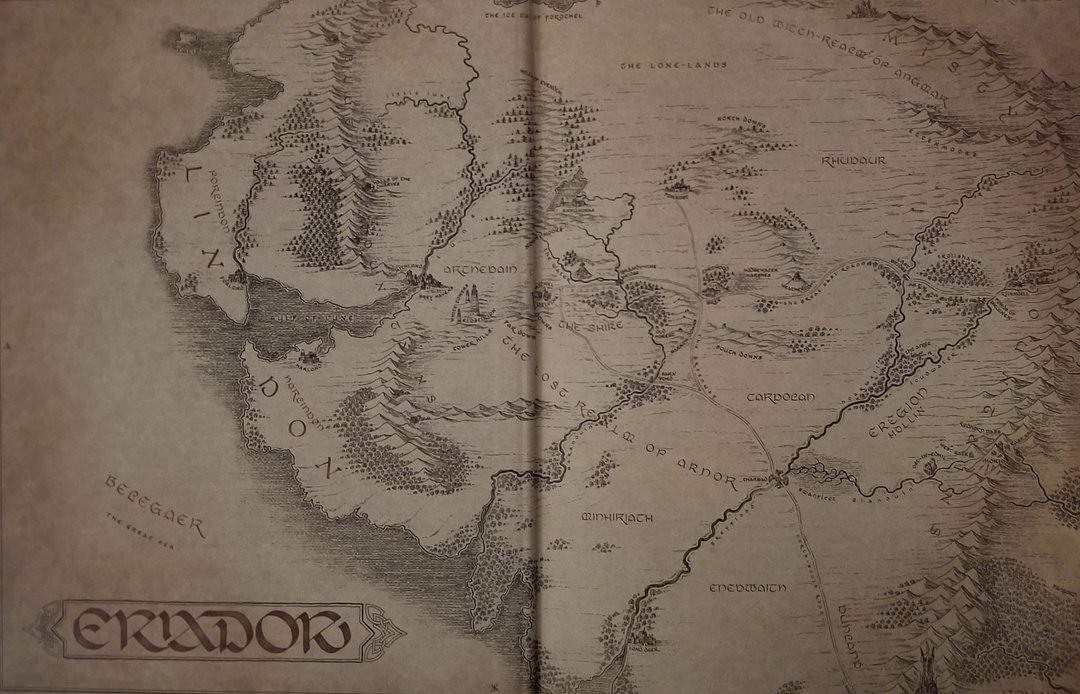
The map of Eriador on the inner cover is extremely evocative of the art style associated with the classic books.
A campaign of The One Ring sees players forming a fellowship under the direction of a patron. For prospective GMs, I’ll just say up front that this is a boon. There’s no awkwardness of “you all meet in a tavern.” You’re together as a group because your characters, through direct involvement with a patron or just your own wanderlust, have made the decision that something needs to be done about the dangers and evils moving throughout your homelands. These patrons could be minor, local lords or people of power, but the book also gives you rules for the major players like Gandalf himself, concerned with the bigger picture across Middle Earth. Or your patron could be Bilbo, ever watchful for the safety of his beloved Shire since his return. Or Tom Bombadil and Lady Goldberry, perhaps more limited in the reach of their lands but no less interested in their wellbeing. Fans who were upset that Tom didn’t factor into the movies will be especially delighted for the inclusion of that last patron in the book.
As you journey, fatigue will take its toll. You’ll be expected to work as the fellowship you are, scouting and managing your camp. You’ll need rest between the hard times of your travels. You’ll encounter the shadow in its various forms, and you’ll need to resist its corruption. You’ll hold councils with those in positions to aid your cause. And of course, you’ll need sturdy gear to see you through your challenges. Over the seasons and years, your hero will see and experience much, perhaps even raising an heir to carry on their tasks once they are gone. One thing is certain amongst all of this: where you may fail as individuals, as a fellowship you can succeed. Your journey will test the very bonds that you all share.
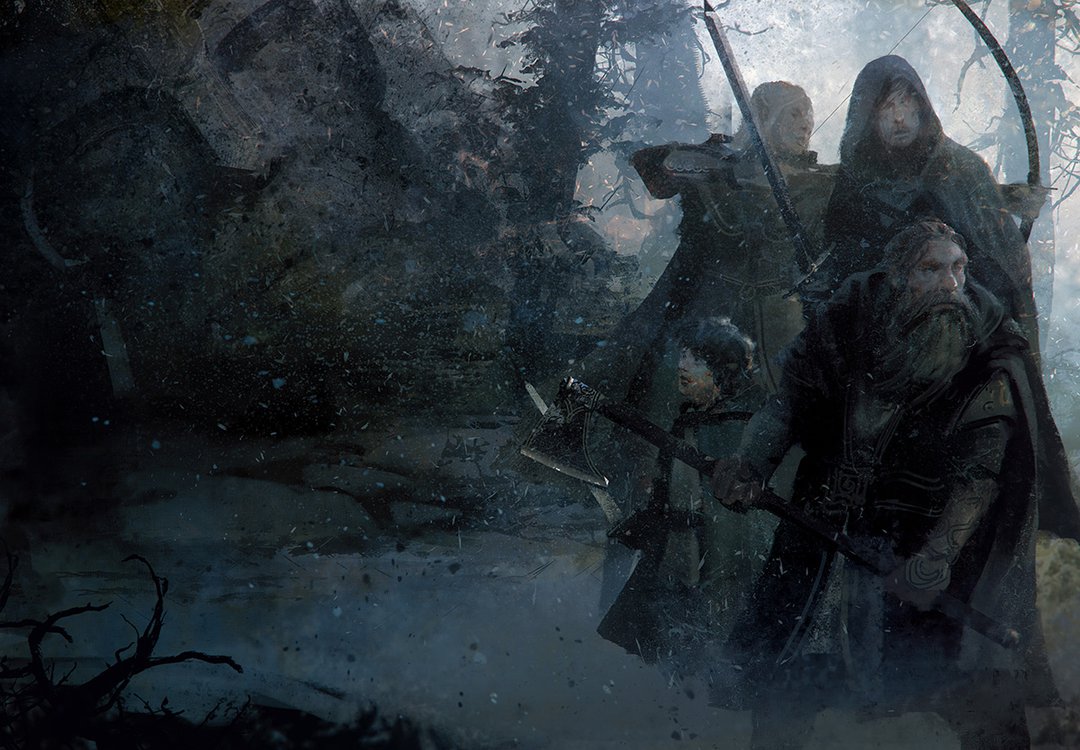
One additional little rule is that your character can have a "fellowship focus" for which you give greater bonuses when helping.
Simple Pleasures
Rules-wise, The One Ring is presented in a very easy-to-pick-up format. I found this a big draw when teaching my group of players as it made mechanics fluid so we could get to the good stuff. The lore and the adventure! All rolls are made with a custom twelve-sided die (a feat die) and some number of six-sided dice (success dice). And before you ask, if you don’t want the special dice, regular ones will work just fine. The more trained your character is in a skill, the more success dice they roll. Feat die results are added to the total of the success dice, and if a target number (TN) is hit, the roll succeeds. Simple! Additionally, if any of the success dice show 6s (the custom dice have an elven rune on them), the roll goes through with added degrees of success. Perhaps you are so stealthy that you can also prevent your lumbering friend from stepping on that noisy twig at just the wrong moment!
Spicing this up is the d12, the feat die. One through ten are added as normal to a roll, while the 11 is replaced by an Eye of Sauron symbol. This normally counts as a zero, but it can also be an automatic failure under certain conditions. The 12 is replaced by a Gandalf rune and usually indicates automatic success. A few rolls and everyone’s got their head around the dice, even in regards to 11s and 12s, linking up our normal dice with the rules for those custom ones. That’s what I like to see when I teach a new system.
The character sheet is laid out perfectly to streamline the process of rolling dice, too. Three columns, aligning with the three stats of the characters, are lined up with the skills and combat rolls relevant to those attributes. Your TNs are predetermined by your strength within those attributes and recorded for easy access. You roll your d12 and some d6s based on your ranks in those skills. Hit or exceed your modified TN, and you do the thing! What’s wonderful right at the outset of this system is that this makes basic rolls easily apparent to players. They know exactly how challenging it is for them to take on various tasks alone, which skills align with which stats/TNs, and if their strength lies in blades or riddles. Players have an immediate sense of their character’s ability, and I love this.
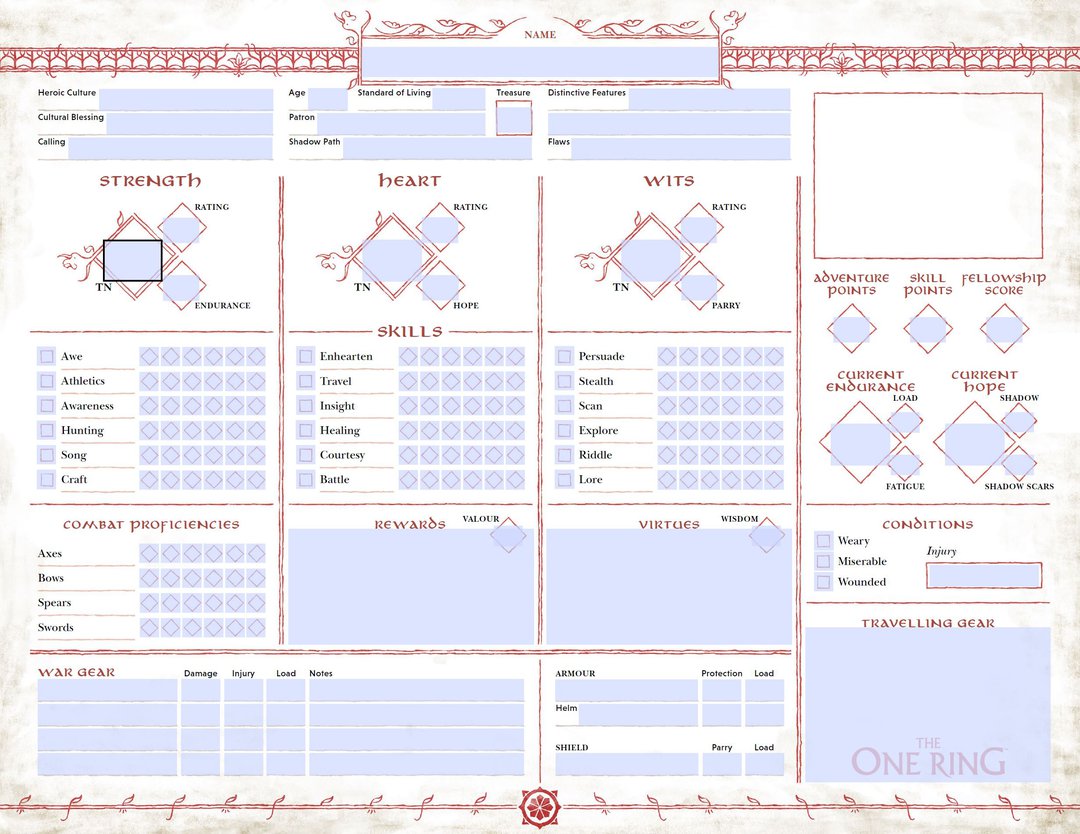
Columns on the character sheet make it very easy to reference what skill goes with what stat, and what target numbers you're aiming to hit. The digital sheets are also form-fillable and have different borders for the different Middle Earth folk.
Of course, the dice goodness doesn’t end there. Any good GM knows that a simple rules system is made all the better by good mechanics for modifiers. And while there’s plenty of opportunity to add or take away dice on player rolls (much more streamlined than tracking varying degrees of plusses or minuses), I also love games that allow players choices for power at the cost of potential drawbacks later on. The One Ring bakes some delicious ones right into the mechanics. Your second attribute is Heart, and it measures your ability to do things like read people, enhearten others, and heal. It also determines a derived stat called Hope. The Hope score is a special pool of points that recharges only under special circumstances. You can spend it to gain +1 die on any roll, or you can gain +2 dice if you are ever considered “inspired,” a special condition often relating to traits you pick out during character creation.
Why would you not burn up all your Hope points then, besides their slow recharge? Well, you see if points of growing shadow on your heart ever reach your current Hope score, that Sauron rune on the feat die turns from a zero to an automatic failure. A little boost now, but at what cost? Hope, as portrayed in the books and movies, is a precious thing that should not be squandered. It can mean all the difference in just the right moments. Putting this agency in the hands of players instead of just the GM is a brilliant move.
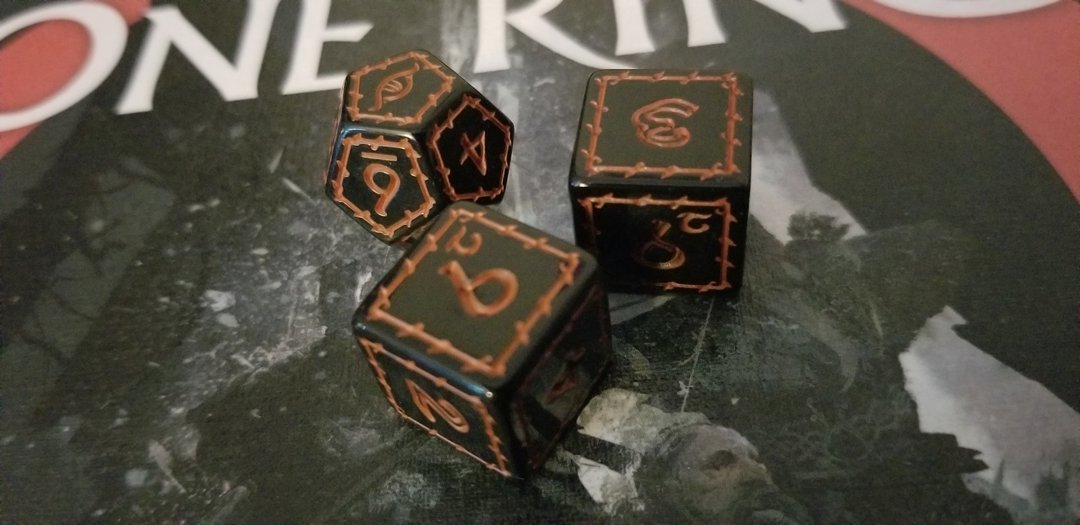
Sample of the custom dice. They also come in a white version.
Combat And More
Let’s talk about two of the systems I am most excited for in The One Ring: combat and the aforementioned shadow point system. As I play more and more TTRPGs, I grow more and more in love with fast, deadly combats. Don’t get me wrong, there are times when a lengthy, tactical combat in a game of D&D gets me going too, but I think personally I am a fan of cinematic moments that can happen and resolve quickly, dovetailing into the action of the plot and the lore players are embroiled in. If you’re like me, then you’ll love combat in The One Ring.
If players are in a position to take advantage of a quick ranged volley (or the enemies are similarly able to do so), ranged shots are exchanged. Players then close into melee with a proper “front line” needed if the less blade-inclined wish to sit back with their bows. There are stances players declare each round which award bonus dice to attack and defense, sometimes making you easier to hit depending on how aggressively you set your stance, but this isn’t where I think the real magic comes into play. You see, while weapons are dealing damage damage, adversary endurance (hit points) dropping lower and lower, and foes are falling after a couple rounds, there’s always the possibility for something called a “piercing blow.” Something like a critical success, when the feat die rolls a 10 (or is modified into a pierce with special abilities and/or weapon enhancements) a foe must roll a sort of “death save” or be instantly slain. Hitting enemies is affected by their parry rating, but this insta-kill is only resisted by armor. Meaning that your dwarven warrior swinging hard with his great axe is nearly guaranteed to cleave that goblin raider in leathers should he roll a pierce.
I love this rule! This one simple addition to combat takes an already quick to play, deadly system and turns it up to 11. It means that, as a GM, you can overwhelm your group with goblins and watch as the foes fall one after another (some characters can be built to pierce on a roll of 8-10 at character creation if that’s your thing). On the other hand, scoring a piercing blow against a mighty orc warrior who’s armor is thick, his shield broad, is cause for celebration in itself. Those cinematic moments in the movies where an orc head goes flying in a gush of black blood, that’s what we’re talking about. Enemies are capable of inflicting this effect on heroes as well, though not in such an extreme (no instant player decapitations here). Should a player suffer a piercing hit, they become “wounded,” a status effect that slows their health recovery when resting. Should they become wounded again while already wounded, they then immediately fall into the dying state, needing the help of their allies to pull through the day. The flair and urgency this gives to combat cannot be overstated.
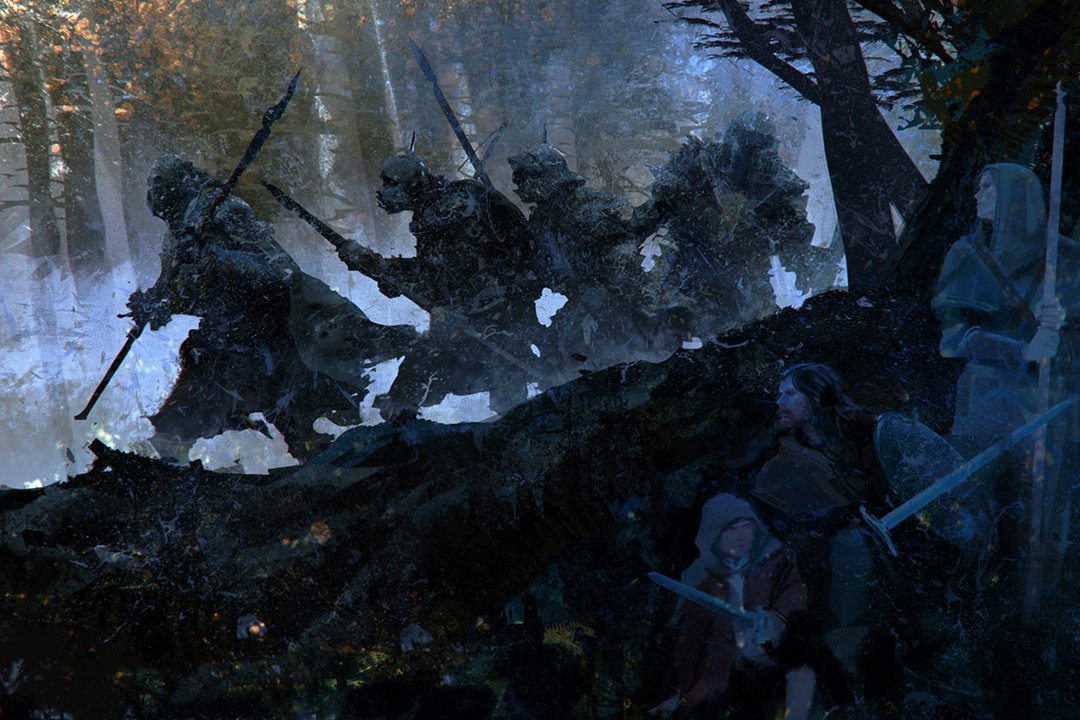
Ah, but when to attack and when to hide? That is perhaps the greater question!
While combat is tense, quick, and exciting, I’m pleased to say that it’s really only half of what makes the conflict in The One Ring so wonderful. Plenty of board and video games have been made within the Lord of the Rings setting, though in my opinion many of them miss the mark on the big themes. The struggle between good and evil, light and dark, is about more than just killing things with swords. The struggle against the shadow is one of a struggle within ourselves. The greatest adversaries that heroes face in standing up to the shadow are their own fears, their insecurities, their greed and desires. The ring itself is dangerous because of how it tempts those that carry it. I’m pleased to relate that beyond just the spending of Hope points and their effect on die rolls, shadow points do so much more in advancing this idea.
If you’ve ever wanted a system that helps track a character’s journey through this darkness, you’re in the right place. Want to have a character who’s got a Boromir arc, resisting but slowly giving in to despair until they lash out at their companions? That could very well happen. There are several tracks within the book, determined by the calling you give your character (think of it like their job class), and as the shadow fills your hope gauge, your heart is affected in different ways particular to that calling. Those that choose a heroic path of combat against foes may find themselves violently lashing out at those undeserving of their ire. Those that love to travel may find themselves suffering an insatiable wanderlust. For those who take a liking to things that glitter, Dragon’s Sickness is a real danger on the horizon that could one day overtake a hero.
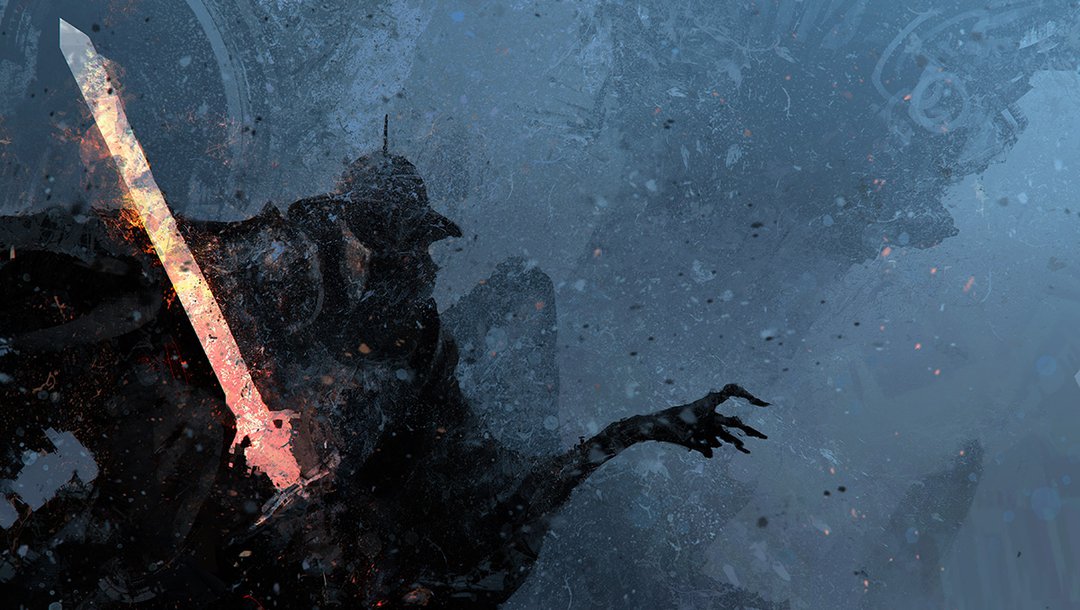
There are dark things out there, but also potentially darkness within a hero must face.
Should a character’s shadow points ever completely fill up to the Hope score’s maximum limit, the hero will suffer being “ill-fated” on all rolls, using two feat dice on all rolls and taking the worse result, until the player has them suffer a moment of madness. The player and GM must stop and figure out a way to let that character play out a meaningful scene in which they lash out. It must leave a lasting mark on the group or character (or both), as well. A few simple, angry words for someone suffering the Curse of Vengeance path will be too easily dismissed. The outburst has to cause some meaningful character progression. Once done, the hero’s shadow points reset to zero, and the character gains a shadow scar. This is a semi-permanent shadow point that’s always considered to be in their pool.
Shadow scars can be removed during special rest times, the Yule celebrations that happen over downtime in the winter season, but the level of shadow gained on their personal path of darkness will forever remain. If a character ever passes four levels of these outbursts which grow more severe each time, they are written out of the game and become a permanent NPC. Think characters like Gollum who have been tormented by the ring for too many years and will now never be free of it. There are other ways to avoid progressing a shadow path, hardening one’s will and taking an early shadow scar to reset one’s points before a moment of madness, but how often should one do this? Would you harden your character’s heart over and over to the point at which they feel no joy any longer? These are the tough, interesting questions that The One Ring poses to players as they play out their stories.
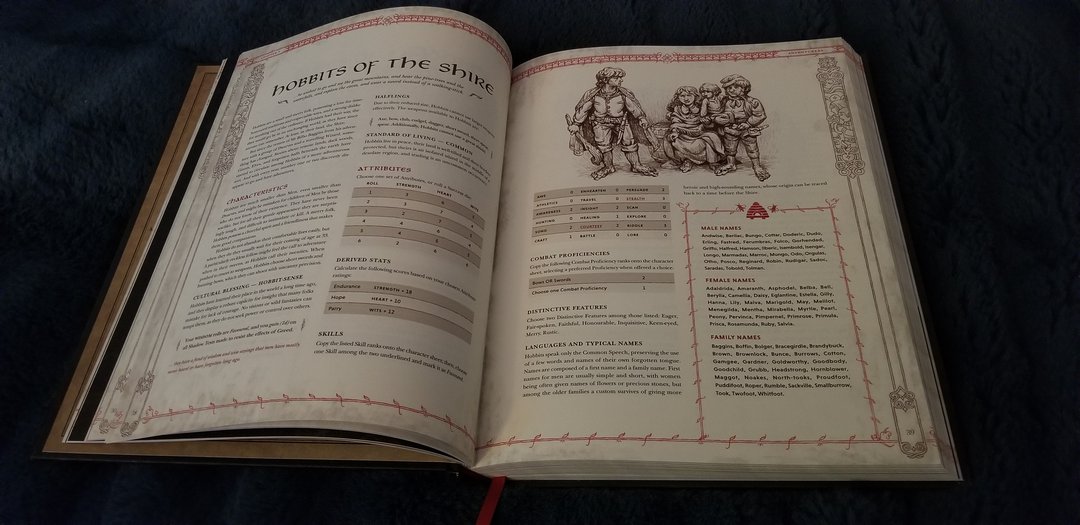
The book itself is laid out with clear formatting and artwork that evokes that nostalgic feeling you could be reading a tome out of Bilbo's study.
This simple point scale mechanic has far-reaching implications in the game, especially given all the ways players can “earn” shadow points. There are no alignments in this system, and players are largely expected to play aspiring heroes concerned with doing good in their lands. So, while salvaging treasure from a troll cave carries no penalty, keeping all the loot after clearing out some bandits who have been harrying a local town might be perceived as greedy. That money and those supplies came from a town that was very clearly suffering from their losses, after all, and not returning it will likely incur a Shadow Test. That is, a roll that’s something like a saving throw to lessen or neutralize the shadow point gain that’s about to hit a character.
Other ways to gain shadow include being hit by dark magic from nasty creatures like wraiths or wights. Or resisting intense fear before particularly intimidating foes. A character might also suffer shadow by witnessing a particularly gruesome scene left behind after an orc raid. These all share one thing in common, though. The player gets a roll to resist the shadow. Should a player ever perform a “misdeed,” they take shadow points with no saving roll allowed. The book does point out that GMs should warn players who are about to commit a misdeed. It should never be a “gotcha” moment. These unavoidable shadow points are reserved for players who clearly stray from the lines of heroism.
What I love about misdeeds, though, is that nothing says your character can’t take that path if they feel the need. For example, the book makes a point of saying that dishonorable tactics against enemies that aren’t monstrous, like say bandits, are considered misdeeds. Nothing says you can’t be prepared with a surprise when you challenge them head-on, perhaps even allowing some to escape with their lives if they surrender, but sneaking into their camp at night to assassinate them in their sleep would definitely be a misdeed. Maybe the odds are too greatly stacked against you, and the burglar in your group makes the Devil’s deal to steal into their camp and poison their water supply, thereby saving the rest of the group from a tough fight. Was it necessary to do things that way? Perhaps it was convenient, but that burglar will definitely find themselves more easily predisposed towards the methods which the paths of shadow lure them towards. Precious few games carrying The Lord of the Rings name are able to capitalize on this internal struggle, and it is definitely one of the greatest selling points for playing The One Ring.
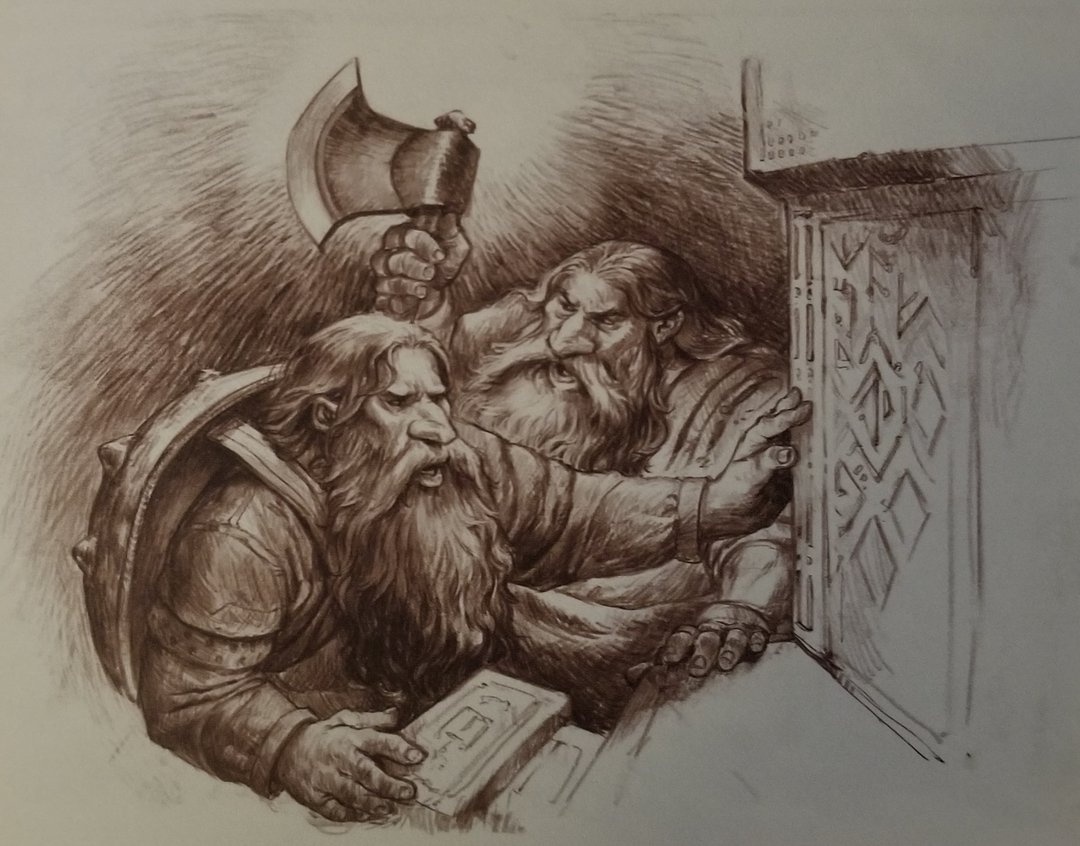
Even reading runes from the speech of Mordor could result in shadow working its way across a character's heart.
Deeper Still
This book has so many little subsystems to emulate all the things we see in The Lord of the Rings. While I’ve spent a good deal of this review discussing the biggest, and most important in my opinion, the others bear mentioning. There is a council system for making multiple skill rolls when in conversation with those you’re seeking aid from, complete with an introduction phase your most courtly of the fellowship should probably handle, meant to give more weight to those scenes of sitting around and convincing others that things need doing. Perfect for getting that leader to mobilize their forces, but also perhaps useful for gaining passage through restricted lands or obtaining help in the form of provisions.
There are also systems for travel and for the threat of The Eye seeing your continued meddlings. The travel system, in my opinion, was a sleeper hit that my group loved. I hadn’t planned to do much with it during my demo game prior to review, but the roleplaying took us into it nonetheless. Within this system players play a little minigame, designating some of their party as guide, scout, and other useful roles for managing their supplies and route as they trek across the land. The One Ring, being set in Middle Earth, acknowledges that the weeks’ long journey across various terrain is something deserving of more than a simple travel montage. There are random event charts and other things that can happen, along with a map broken into hexes in the back of the book, to help determine where you are and what happens along the way. Any GM could make these things up as a group travels, but I’m always happy to see games that give mechanical rules-space in these cases, lending a hand to those that need it.
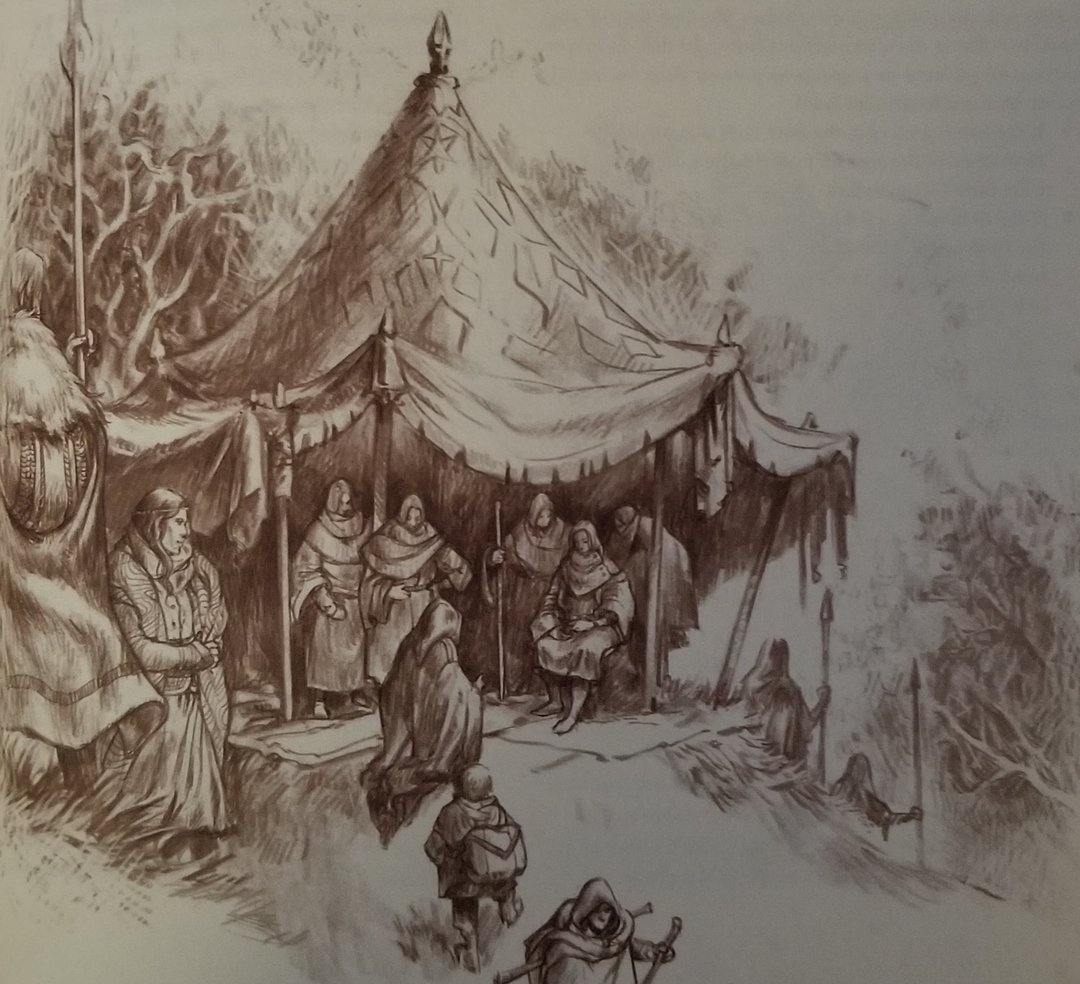
The ability to hold successful councils should not be understated. No fellowship can succeed alone.
I especially love this journey system because it links the thematic travel throughout this evocative setting to your character’s overall well-being. The Endurance stat is your hero’s carrying capacity, but it’s also their health. When you take hits, your Endurance drops. Meaning you can carry less treasure when the fight’s done, or maybe you have to drop your shield in combat to focus your remaining energy into the fight. But it also means that happenings on the road can wear down your endurance as well. Fatigue can build up, ensuring that if you’re going into combat without a proper chance to rest and recover, you are putting yourself at a disadvantage from the get-go. That is, if you even have a chance to rest once you arrive at your destination. My respect is renewed for the Rider of Rohan, arriving in Gondor after 3 days of straight riding, still with the strength to fight.
The Eye of Sauron is also ever sweeping across the lands, looking more intently at those it deems a threat to its machinations. As the players do more and more to hamper the shadow, it may take specific note of them and move forces purposefully against them. Honestly, for what sounds like a fantastic mechanic I found this one aspect to lack more than a little; while the concept is intriguing, the consequences often amount to little more than slightly more foes or slightly more tough ones than normal. Nothing really stands out here to signal to a group that they’ve finally crossed the line, like having a lieutenant of the dark sent out to track the fellowship. This is, of course, easily fixed by some house rules and expanded consequences by the GM. It was just a little sad to see it so conservatively put forth in the book for what could have been another thrilling addition as printed. At the very least, a little extra care should be given by GMs so that a foe with slightly more ability sent as a result of this mechanic gets a little extra cinematic flair and character to enhance the mood.
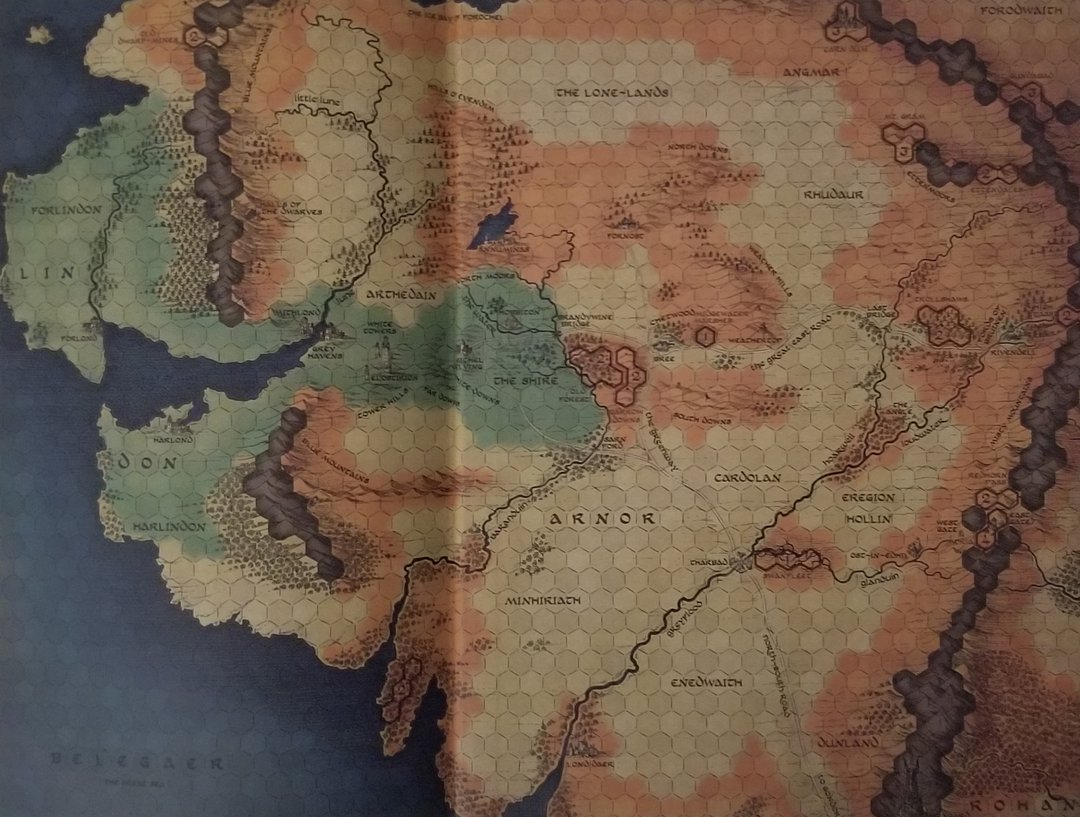
The back cover of the book contains the same map as the front cover but broken into hex movement and threat zones.
When It All Comes Together
Let’s be honest here. We’ve talked about several little systems that all come together to make this new second edition of The One Ring interesting and engaging, but none of them are truly where this game is at its best. The big draw that gets players and GMs into this system, first and foremost, is the setting. It’s what gets people playing this game over any other of the myriad of other fantasy settings out there. My criticisms of this system are that everything on paper looks just a little too stale. Just a little too “roll to put encounters in the journey” and “roll some more for the Eye to throw a random encounter at the group” and “roll a few more times to create some magical gear for the players to find.” Combat itself can get a bit samey after a while with your options generally being to set your stance offensively or defensively and then just roll. Maybe you get some added effects from your dice results, and maybe you just trade swings with the baddies. As much as I love the mechanics of this system, as easy to teach and solid as they are, I have to admit that they’re nothing that special. There’s a lot of roll, roll, roll.
While you could say that any TTRPG can be reduced to rolls, I would disagree. Rolls are mechanics for moving along the resolution of skills and scenes, and they can be exciting in themselves, but they should always work in greater service to what really keeps a game flowing: the story and characters. Failures can be fantastic moments, the times when the rolls go badly and make things tense and interesting. In these moments, it’s the narrative and how the GM and players collaborate to tell a story together that make the experience something memorable. This is where all these various systems in The One Ring come together to make something greater. If we’re going to boil a system down to its core, let’s talk about stories that a game creates.
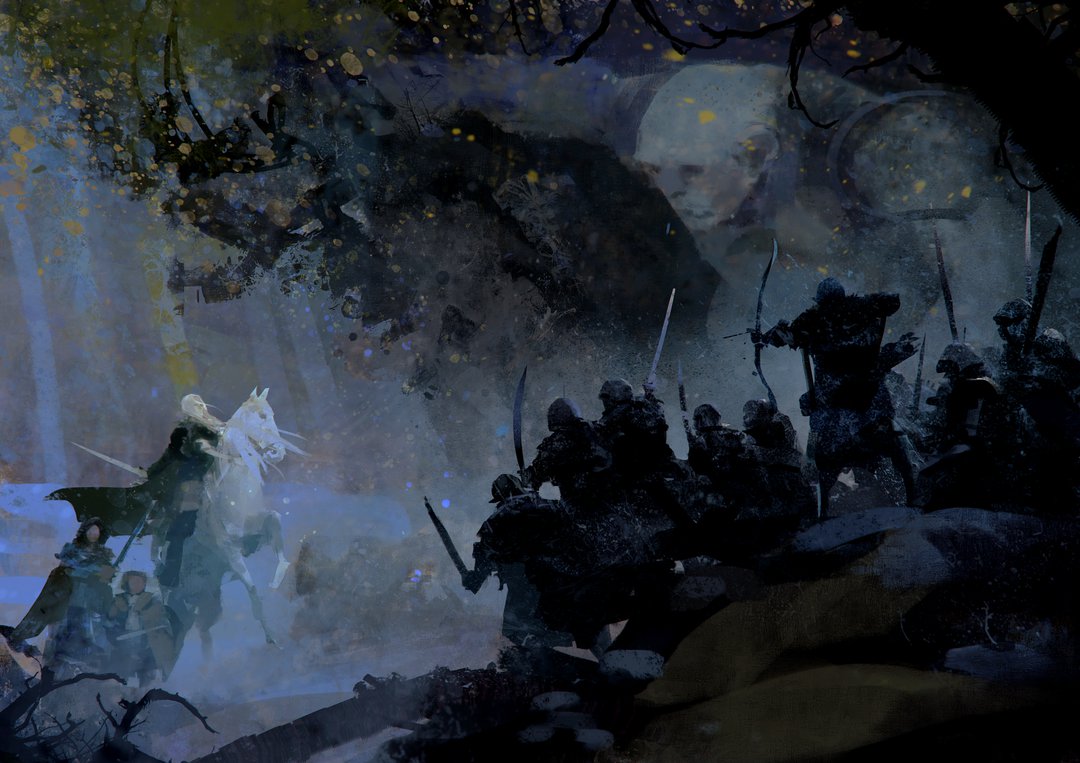
The epic battles as well as the quiet interludes all make for key story moments!
If you were to strip away Middle Earth, I think there’d be nothing particularly remarkable about this game, solid as the systems are. But when you find an elven long blade in a treasure cache, as your character learns its properties and uncovers the story the GM has carefully woven into how this particular artifact made its way to this specific part of the map, something greater emerges. When characters fail their shadow tests and their shadow points creep ever closer to their hope limit, as that darkness presses upon their minds and hearts, the story comes alive. All dice rolling in The One Ring is a relatively simple affair, but as they translate into narrative, everything explodes in brilliant colors.
Things that are so often overlooked in other settings are given a certain, special reverence in this system. A magic sword isn’t just a magic sword that kills things better. It’s Sting, and it makes sure Orcs never get an ambush off on you! You don’t just spend three days travelling east from Bree. You tromp through the Midgewater Marshes to shake the trail of something following your fellowship, and you trace a path across the country to the beacon at Weathertop that Frodo and his own fellowship will take several decades later. When I say you play The One Ring because you want Middle Earth, that comes with all the richness that exists in the setting, and any of the books you’ve read or media you’ve watched add to your pool of lore you can draw from.
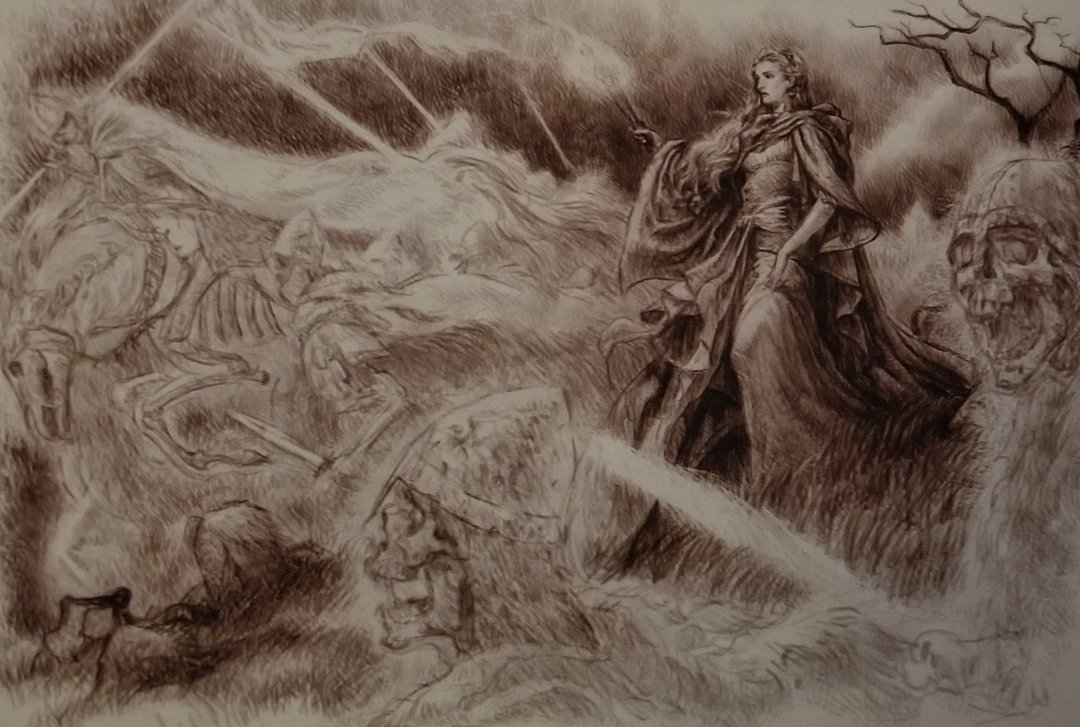
As they level up, heroes can draw from traits specific to their folk as well as a pool of general bonuses. Elves, for example, have an uncanny ability to sense undead others cannot.
We should mention one last bit here, and that’s for folks who are concerned with the inconsistencies between, say, works like The Hobbit and The Lord of the Rings. Or maybe you’re afraid of “messing up” Middle Earth if you’re not picture perfect on your lore. The game book dedicates an entire section to this. In short, you as the GM are free to play within Middle Earth and weave in the lore as you see fit. Bilbo can be treated as both a source of knowledge and an unreliable narrator, telling his account of things tainted by his own perspective if that suits you. Similarly, Middle Earth is a big place, and you’re welcome to flesh out stories that aren’t part of the official canon. Nothing says a fellowship couldn’t have a whole side adventure leading up to a big confrontation in Angmar that ultimately helps the main protagonists of the series years later. Maybe Gandalf’s your patron because that’s part of his master plan from the start! The point is, whether you’re a newbie who’s intrigued by the setting or a total lore buff, you have room to tell the stories you want to tell within the lands of The One Ring.
The Road Goes Ever On And On
When you buy a Lord of the Rings TTRPG, what do you want to bring to your table? I’d be willing to bet what you want is a system that lets you do “all the Middle Earth things.” You want the maps and the monsters and rules to make glowing swords and fantastical rings. You want your characters to win smoke ring blowing contests in the Shire. In fact, you want to run an all-Hobbit game centered on the Shire! Or maybe you want to run an all-Dwarf game akin to a Thorin Oakenshield adventure. Whatever you want, you want to build it in Middle Earth because you love the setting and the lore and want to bring it to life.
If an entire core book is too intimidating to jump right into, there’s a starter kit to help you along with condensed rules and several pre-built adventures to get you going (also included are some custom dice the group can share and plenty of reference materials and maps). On the other hand, while I’m sure more material will eventually be released for this edition of the game, if you want to go off the deep end there’s already so much existing lore for the larger world that you could easily branch your group off the core book’s map and visit Rohan or Erebor. The book gives you enough existing baddies which are easy enough to use as templates for making your own and even includes a section for creating Nameless Things, unknowable and dark monsters unique to your own story.
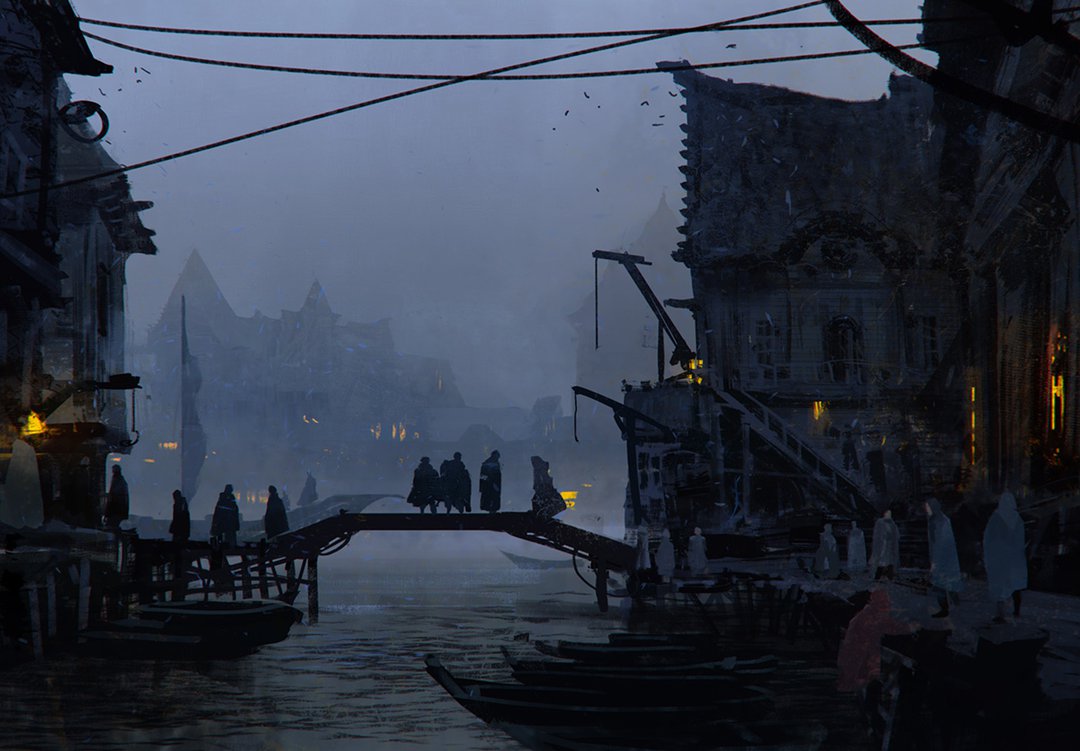
The limit of your adventures is only your imagination.
Basically, what I’m saying here is that with this one book you can go as little or as big as you want within the lands of Middle Earth, and that’s lot of value! If you choose to keep your story centered in Eriador, with just the material provided in this new second edition core book, know that you get plenty to play with. The One Ring does literally all The Lord of the Rings things, so if this is what you’ve been looking for, look no further. I cannot recommend this game highly enough to fans of The Lord of the Rings. If you’ve been drooling over the idea of shadow points, or piercing blows, or smoke ring blowing contests, don’t hesitate on picking up a copy for yourself. This book does what all good core books do: it lays the foundation for both starting in a system while giving you the possibility of expanding your games as far as your journey wants to take you. As Tolkien himself once wrote:
The Road goes ever on and on
Down from the door where it began.
Now far ahead the Road has gone,
And I must follow, if I can,
Pursuing it with eager feet,
Until it joins some larger way
Where many paths and errands meet.
And whither then? I cannot say.